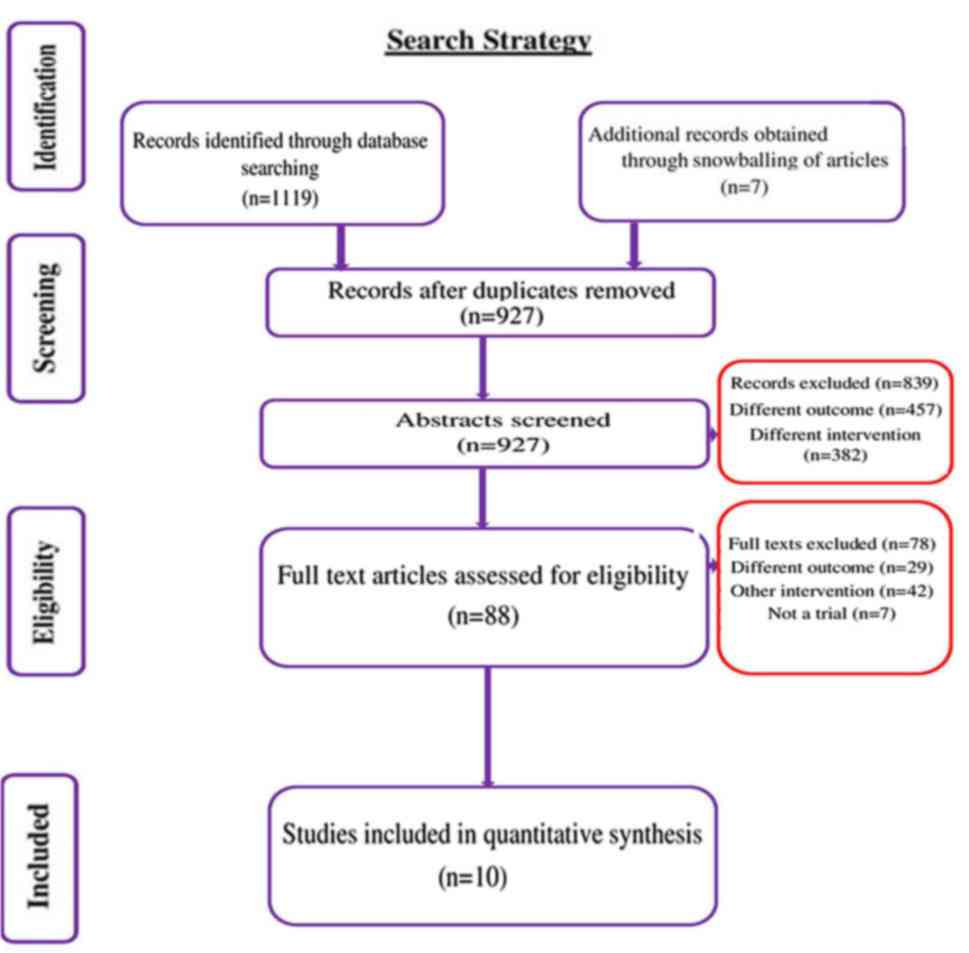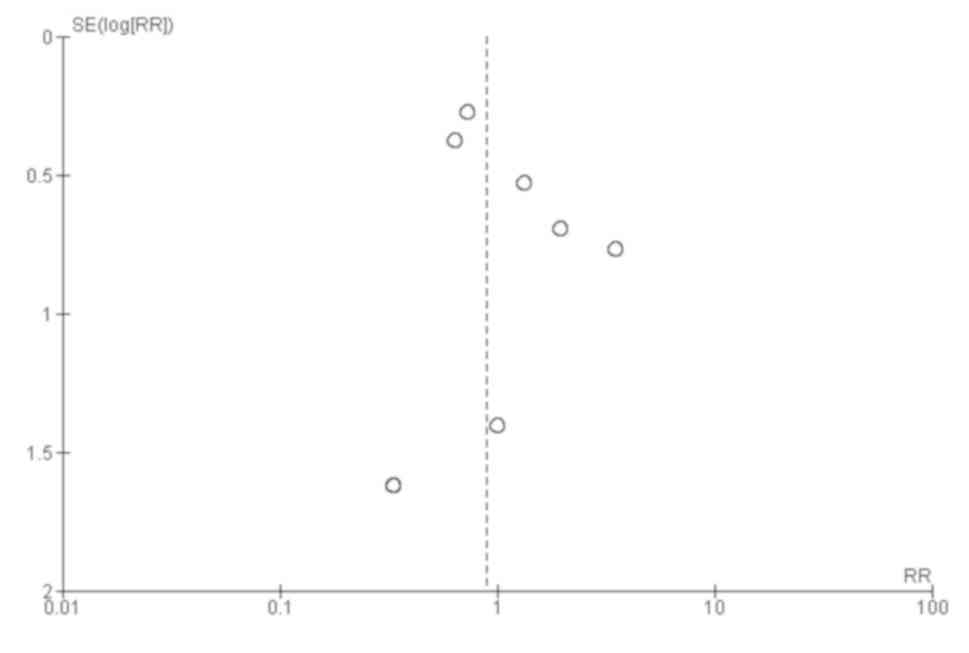|
1
|
García-Gubern CF, Colon-Rolon L and Bond
MC: Essential concepts of wound management. Emerg Med Clin North
Am. 28:951–967. 2010.PubMed/NCBI View Article : Google Scholar
|
|
2
|
Ahn HB, Shin DM, Roh MS, Jeung WJ, Park WC
and Rho SH: A comparison of 2-octyl cyanoacrylate adhesives versus
conventional suture materials for eyelid wound closure in rabbits.
Korean J Ophthalmol. 25:121–127. 2011.PubMed/NCBI View Article : Google Scholar
|
|
3
|
Biancari F and Tiozzo V: Staples versus
sutures for closing leg wounds after vein graft harvesting for
coronary artery bypass surgery. Cochrane Database Syst Rev.
5(CD008057)2010.doi: 10.1002/14651858.CD008057. PubMed/NCBI View Article : Google Scholar
|
|
4
|
Hasan Z, Gangopadhyay AN, Gupta DK,
Srivastava P and Sharma SP: Sutureless skin closure with isoamyl
2-cyanoacrylate in pediatric day-care surgery. Pediatr Surg Int.
25:1123–1125. 2009.PubMed/NCBI View Article : Google Scholar
|
|
5
|
Lawrence WT: Physiology of the acute
wound. Clin Plast Surg. 25:321–340. 1998.PubMed/NCBI
|
|
6
|
Hutchinson JJ and Lawrence JC: Wound
infection under occlusive dressings. J Hosp Infect. 17:83–94.
1991.PubMed/NCBI View Article : Google Scholar
|
|
7
|
Mertz PM, Marshall DA and Eaglstein WH:
Occlusive wound dressings to prevent bacterial invasion and wound
infection. J Am Acad Dermatol. 12:662–668. 1985.PubMed/NCBI View Article : Google Scholar
|
|
8
|
Ubbink DT, Vermeulen H, Goossens A, Kelner
RB, Schreuder SM and Lubbers MJ: Occlusive vs gauze dressings for
local wound care in surgical patients: A randomized clinical trial.
Arch Surg. 143:950–955. 2008.PubMed/NCBI View Article : Google Scholar
|
|
9
|
Dyson M, Young S, Pendle CL, Webster DF
and Lang SM: Comparison of the effects of moist and dry conditions
on dermal repair. J Invest Dermatol. 91:434–439. 1988.PubMed/NCBI View Article : Google Scholar
|
|
10
|
Cutting KF and White RJ: Maceration of the
skin and wound bed. 1: Its nature and causes. J Wound Care.
11:275–278. 2002.PubMed/NCBI View Article : Google Scholar
|
|
11
|
Merei JM: Pediatric clean surgical wounds:
Is dressing necessary? J Pediatr Surg. 39:1871–1873.
2004.PubMed/NCBI View Article : Google Scholar
|
|
12
|
Chrintz H, Vibits H, Cordtz TO, Harreby
JS, Waaddegaard P and Larsen SO: Need for surgical wound dressing.
Br J Surg. 76:204–205. 1989.PubMed/NCBI View Article : Google Scholar
|
|
13
|
Dosseh Eacute Koué D, Doleaglenou A,
Fortey YK and Ayite AE: Randomized trial comparing dressing to no
dressing of surgical wounds in a tropical setting. J Chir (Paris).
145:143–146. 2008.(In French). PubMed/NCBI
|
|
14
|
Gwosdow AR, Cunningham JJ, Lydon M,
Rascati R and Berglund LG: Evaporative water losses through a
temporary wound dressing under simulated wound conditions. J Burn
Care Rehabil. 14:450–454. 1993.PubMed/NCBI View Article : Google Scholar
|
|
15
|
Ajao OG: Surgical wound infection: A
comparison between dressed and undressed wounds. J Trop Med Hyg.
80:192–196. 1977.PubMed/NCBI
|
|
16
|
Mendes DA, Veiga DF, Veiga-Filho J, Loyola
ABAT, Paiva LF, Novo NF, Sabino-Neto M and Ferreira LM: Influence
of dressing application time after breast augmentation on cutaneous
colonization: A randomized clinical trial. J Plast Reconstr Aesthet
Surg. 71:906–912. 2018.PubMed/NCBI View Article : Google Scholar
|
|
17
|
Nesrallah M, Cole P and Kiley K: The
effect of timing of removal of wound dressing on surgical site
infection rate after cesarean delivery. Obstet Gynecol.
129:148–149. 2017.PubMed/NCBI View Article : Google Scholar
|
|
18
|
Peleg D, Eberstark E, Warsof SL, Cohen N
and Ben Shachar I: Early wound dressing removal after scheduled
cesarean delivery: A randomized controlled trial. Am J Obstet
Gynecol. 215(388.e1-388.e5)2016.PubMed/NCBI View Article : Google Scholar
|
|
19
|
Ramkumar S, Narayanan V and Laing JHE:
Twenty-four hours or 10 days? A prospective randomised controlled
trial in children comparing head bandages following pinnaplasty. J
Plast Reconstr Aesthet Surg. 59:969–974. 2006.PubMed/NCBI View Article : Google Scholar
|
|
20
|
Ritting AW, Leger R, O'Malley MP,
Mogielnicki H, Tucker R and Rodner CM: Duration of postoperative
dressing after mini-open carpal tunnel release: A prospective,
randomized trial. J Hand Surg Am. 37:3–8. 2012.PubMed/NCBI View Article : Google Scholar
|
|
21
|
Veiga DF, Damasceno CAV, Veiga-Filho J,
Paiva LF, Fonseca FE, Cabral IV, Pinto NL, Juliano Y and Ferreira
LM: Dressing wear time after breast reconstruction: A randomized
clinical trial. PLoS One. 11(e0166356)2016.PubMed/NCBI View Article : Google Scholar
|
|
22
|
Veiga-Filho J, Veiga DF, Sabino-Neto M,
Damasceno CA, Sales EM, Garcia ES, Oliveira IB, De Simoni LF,
Juliano Y and Ferreira LM: Dressing wear time after reduction
mammaplasty: A randomized controlled trial. Plast Reconstr Surg.
129(1e-7e)2012.PubMed/NCBI View Article : Google Scholar
|
|
23
|
Wipke-Tevis DD and Stotts NA: Effect of
dressings on saphenous vein harvest incision pain, distress and
cosmetic result. Prog Cardiovasc Nurs. 13:3–13. 1998.PubMed/NCBI
|
|
24
|
Toon CD, Lusuku C, Ramamoorthy R, Davidson
BR and Gurusamy KS: Early versus delayed dressing removal after
primary closure of clean and clean-contaminated surgical wounds.
Cochrane Database Syst Rev. 3(CD010259)2015.doi:
10.1002/14651858.CD010259. PubMed/NCBI View Article : Google Scholar
|
|
25
|
Sood A, Granick MS and Tomaselli NL: Wound
Dressings and Comparative Effectiveness Data. Adv Wound Care.
8:511–529. 2014.PubMed/NCBI View Article : Google Scholar
|
|
26
|
Gethin G and Cowman S: Manuka honey vs.
hydrogel -a prospective, open label, multicentre, randomized
controlled trial to compare desloughing efficacy and healing
outcomes in venous ulcers. J Clin Nurs. 18:466–474. 2009.
|
|
27
|
Gupta SS, Singh O, Bhagel PS, et al: Honey
dressings versus silver sulfadiazine dressing for wound healing in
burn patients: A retrospective study. J Cutan Aesthet Surg.
4:183–187. 2011.PubMed/NCBI View Article : Google Scholar
|






















